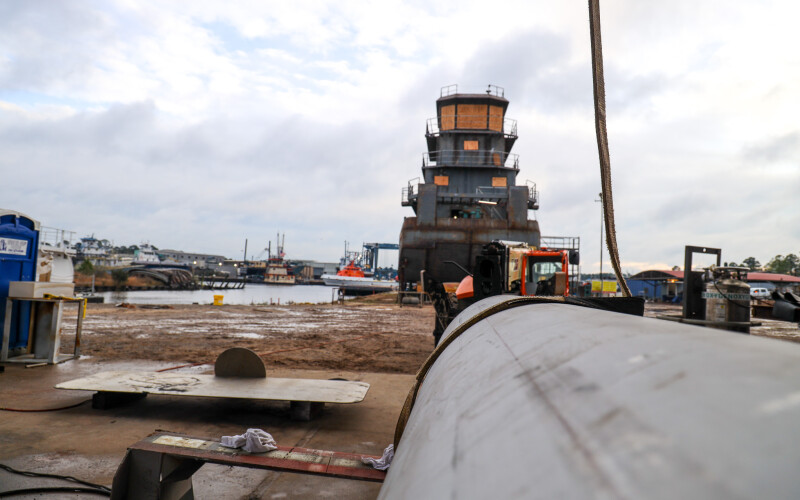There’s an old saying that goes, “I’m in pretty good shape for the shape I’m in.” That’s a good description of the tug and barge industry.
Yes, there are always problems, such as droughts and floods, personnel shortages, overbuilt barge fleets, and lock and dam failures. But the inland industry has been dealing with these problems for decades. Tug and barge companies know how to navigate those strong currents.
“In the 22 years that I’ve been in this industry, the three downturns that I’ve been a part of, the resilience of this industry is incredible,” Clark Todd, president, and CEO Blessey Marine Services, Harahan, La., said at the Inland Marine Expo (IMX) in Nashville, Tenn., in May. He said that currently, the inland marketplace “is in a true state of equilibrium.”
FINANCIAL ASSISTANCE
Still, no matter how experienced business owners are, a little help is always welcome. The U.S. Maritime Administration (Marad) has financial aid programs that can do just that.
Marad sent Daniel Ladd, its director of the office of financial approval, and Travis Black, director of Inland Waterways Gateway Office in St. Louis, to IMX to discuss a few of Marad’s financial programs available to the tug and barge industry.
Ladd said Marad has a vessel assistance program that exists to support the economic and national security objectives of the U.S. to “strengthen the maritime industry — critical to our economy, maintain domestic shipbuilding and maintenance, and sustain a vibrant U.S. merchant marine.”
He discussed the Federal Ship Financing Program (Title XI), which provides funding to construct new vessels, reconstruct existing vessels, and modernize shipyard facilities. Currently, offshore wind farm boats are considered vessels of national interest and are being given processing and funding priorities, including new construction and rebuilding of existing vessels.
Under Title XI, Marad provides up to 75% of the cost for barges and up to 87.5% of the cost of certain vessels for a period of up to 25 years. The interest rates are based on U.S. Treasury rates.
Canal Barge Co., New Orleans, had a $53.3 million Title XI loan application approved last summer for the construction of 17 barges and three towboats.
Other Marad programs discussed at IMX included the U.S. Marine Highway Program and Small Shipyard Grants Program. Small shipyard grants can make a difference as to whether a barge, towboat, or tug construction project can move forward.
The shipyard grants program finances capital and related improvements to qualified shipyard facilities that will be effective in fostering efficiency, competitive operations, and quality ship construction, repair, and reconfiguration, according to Marad. It will also provide training for workers in shipbuilding, ship repair, and associated industries.
Historically, the program has selected roughly 15 to 30 applications to receive funding each year and the average grant amount has been approximately $1 million. The feds pick up to 75% of the funding, with the shipyard is responsible for the other 25%.
This year, Marad doled out $20.8 million in grant award money to 27 shipyards in 20 states. Since 2008, Marad has awarded $303 million to almost 350 shipyards in 32 U.S. states and territories.
“There’s been an awful lot of activity from the inland waterways for this program,” said Ladd, “particularly with companies trying to get in Subchapter M compliance.”
Marad’s Marine Highway Program has one major goal: expand the use of U.S. navigable waters. Marad works closely with public and private organizations to:
- Develop and broaden marine highway service options and facilitate their further integration into the current U.S. surface transportation system, especially where water-based transport is the most efficient, effective, and sustainable option.
- Highlight the benefits, increase public awareness, and promote waterways as a viable alternative to “landside” shipping and transportation options.
Marine highway transportation includes the carriage by a documented vessel of bulk, liquid, or loose cargo loaded in tanks, holds, hoppers, or on deck bulk, liquid, and loose cargo (including carriage of cargo and passengers).
It includes shipments loaded at a port in the U.S. and unloaded either at another U.S. port or at a port in Canada or Mexico, or loaded at a port in Canada or Mexico and unloaded at a U.S. port. (No grant funds can be used outside of the U.S.)
Marine Highway Program grant funds can be used for port and landside infrastructure, cargo handling equipment, a new or used vessel purchase, lease, or modification, and planning, preparation, and design efforts in support of Marine Highway Program projects (Marine Highway Program funds cannot be used for market-related studies).
The Marine Highway Program said Black, “works with manufacturers, vessel operators, ports, and public and private stakeholders to build economically competitive alternative supply chains that utilize our waterways, incorporates routes into the National Freight Strategic Plan and National Multimodal Freight Network for an integrated transportation system, and administers grants to address capital risks and other obstacles to service development.”
He said there is $12.4 million available to applicants for fiscal year 2023. “People are taking advantage of these programs.”




